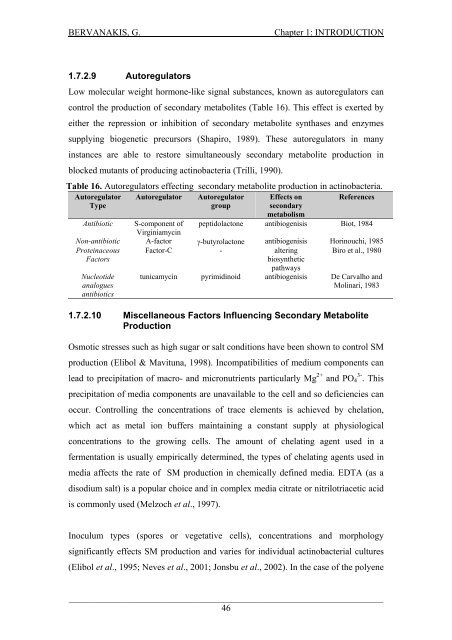Detection and Expression of Biosynthetic Genes in Actinobacteria ...
Detection and Expression of Biosynthetic Genes in Actinobacteria ...
Detection and Expression of Biosynthetic Genes in Actinobacteria ...
You also want an ePaper? Increase the reach of your titles
YUMPU automatically turns print PDFs into web optimized ePapers that Google loves.
BERVANAKIS, G.Chapter 1: INTRODUCTION1.7.2.9 AutoregulatorsLow molecular weight hormone-like signal substances, known as autoregulators cancontrol the production <strong>of</strong> secondary metabolites (Table 16). This effect is exerted byeither the repression or <strong>in</strong>hibition <strong>of</strong> secondary metabolite synthases <strong>and</strong> enzymessupply<strong>in</strong>g biogenetic precursors (Shapiro, 1989). These autoregulators <strong>in</strong> many<strong>in</strong>stances are able to restore simultaneously secondary metabolite production <strong>in</strong>blocked mutants <strong>of</strong> produc<strong>in</strong>g act<strong>in</strong>obacteria (Trilli, 1990).Table 16. Autoregulators effect<strong>in</strong>g secondary metabolite production <strong>in</strong> act<strong>in</strong>obacteria.Autoregulator Autoregulator Autoregulator Effects on ReferencesTypegroupsecondarymetabolismAntibiotic S-component <strong>of</strong> peptidolactone antibiogenisis Biot, 1984Virg<strong>in</strong>iamyc<strong>in</strong>Non-antibiotic A-factor γ-butyrolactone antibiogenisis Hor<strong>in</strong>ouchi, 1985Prote<strong>in</strong>aceousFactorsFactor-C - alter<strong>in</strong>gbiosyntheticBiro et al., 1980Nucleotideanaloguesantibioticspathwaystunicamyc<strong>in</strong> pyrimid<strong>in</strong>oid antibiogenisis De Carvalho <strong>and</strong>Mol<strong>in</strong>ari, 19831.7.2.10 Miscellaneous Factors Influenc<strong>in</strong>g Secondary MetaboliteProductionOsmotic stresses such as high sugar or salt conditions have been shown to control SMproduction (Elibol & Mavituna, 1998). Incompatibilities <strong>of</strong> medium components canlead to precipitation <strong>of</strong> macro- <strong>and</strong> micronutrients particularly Mg 2+ <strong>and</strong> PO 4 3- . Thisprecipitation <strong>of</strong> media components are unavailable to the cell <strong>and</strong> so deficiencies canoccur. Controll<strong>in</strong>g the concentrations <strong>of</strong> trace elements is achieved by chelation,which act as metal ion buffers ma<strong>in</strong>ta<strong>in</strong><strong>in</strong>g a constant supply at physiologicalconcentrations to the grow<strong>in</strong>g cells. The amount <strong>of</strong> chelat<strong>in</strong>g agent used <strong>in</strong> afermentation is usually empirically determ<strong>in</strong>ed, the types <strong>of</strong> chelat<strong>in</strong>g agents used <strong>in</strong>media affects the rate <strong>of</strong> SM production <strong>in</strong> chemically def<strong>in</strong>ed media. EDTA (as adisodium salt) is a popular choice <strong>and</strong> <strong>in</strong> complex media citrate or nitrilotriacetic acidis commonly used (Melzoch et al., 1997).Inoculum types (spores or vegetative cells), concentrations <strong>and</strong> morphologysignificantly effects SM production <strong>and</strong> varies for <strong>in</strong>dividual act<strong>in</strong>obacterial cultures(Elibol et al., 1995; Neves et al., 2001; Jonsbu et al., 2002). In the case <strong>of</strong> the polyene_____________________________________________________________________46















